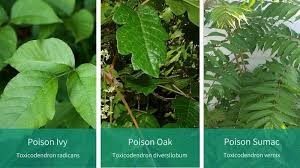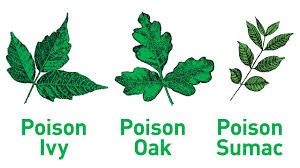by Saundra McBrearty, Outreach and Volunteer Specialist
 It is true these plants offer valuable food and shelter to many animals and insects in the forest, however for people, these poisonous plants are souvenirs we just do not want to bring home with us after an outdoor adventure. Staying clear from these pesky plants, which can leave a person itching for weeks, is a vital skill for nature lovers.
It is true these plants offer valuable food and shelter to many animals and insects in the forest, however for people, these poisonous plants are souvenirs we just do not want to bring home with us after an outdoor adventure. Staying clear from these pesky plants, which can leave a person itching for weeks, is a vital skill for nature lovers.
“Leaves of three, let them be” is a useful piece of wisdom, but lots of plants have “leaves of three,” and they’re not all poisonous. So, what do you need to know to stay itch-free?
Poison Oak
Well, let’s start with the good news. Poison oak doesn’t grow in Ohio. So, check that one off your worry list! It’s most commonly found in the southern and western United States.
Poison Ivy
Poison ivy is very common in Ohio. It can grow like a vine or ground cover and it can even get you itching in the winter when it has no leaves. Poison ivy contains a chemical called urushiol that causes the itchy rash. You can get poison ivy by touching the plant directly or by touching something else that came into contact with it — like your dog. It usually takes about 24 hours for the rash to show up, and a few weeks for it to go away. Surprisingly, the rash is not contagious.
What Does It Look Like?
Poison ivy has leaves that grow in groups of three. The middle leaf has a longer stem than the two side leaves, and there may be small white or yellow flowers attached. The stem looks like it has tiny hairs growing out of it. In the winter, there may be just a vine, or a vine with white berries. In the spring, the leaves start out red and then turn green. They stay green all summer and then change to red or orange in the fall.
What Should I Do?
If you come into contact with poison ivy, wash your skin immediately using dish soap and COLD water (warm water can actually cause the urushiol to penetrate deeper). You can also clean the area with rubbing alcohol. You’ll want to be sure to wash your clothes or any other item that may have touched the plant as well.
Poison sumac is considered the most toxic plant in the country. However, on a positive note, it’s also much rarer than the others. It only grows in super wet areas, like bogs or swamps. Just like poison ivy, sumac also contains urushiol. That means it causes the same itchy rash as poison ivy and you should use the same protocol. Wash right away using the instructions above.
What Does It Look Like?
Poison sumac can look like a bush or grow into a tree. It has red or brown stems that grow clusters of about 10 leaves each. Except for the leaf at the tip of the stem, the leaves grow in pairs opposite one another. Leaves are green in the spring and summer, then change color and drop in autumn. There may be clusters of white berries hanging from the branches during the winter.
Prevent
Avoiding contact with poisonous plants is obviously the best way to prevent “the itch.” And now that you know what you’re looking for, that should be a lot easier. However, sometimes those plants can sneak up on you. To lessen your chance of direct contact:
- Wear long sleeves and pants to keep your body covered.
- Walk on cleared paths.
- Be sure to remove any poison ivy or sumac that’s growing in your yard. NEVER burn the plants. Inhaling the smoke can cause a severe allergic reaction.
- Keep your dog out of wooded areas.
- Consider applying a poison ivy/sumac barrier cream.
- Wash yourself and anything that may have come in contact with a poison plant right away.
Treat
If you develop a poison ivy or sumac rash, you can help calm the itch with:
- Antihistamine
- Cold compress
- Hydrocortisone cream
- Oatmeal bath
See your doctor right away if:
- Rash/blisters spread to your mouth, face or genitals
- You have a wide-spread rash
- Your rash lasts more than a few weeks
- You think your blisters may be infected
Call 911 immediately if you have:
- Trouble breathing or swallowing
- Swelling, especially on your face
- Itching over most of your body and you can’t get relief
Click here to listen to The Coasters sing Poison Ivy.








